Mankind's macho, mean-spirited, venal and
tawdry
destruction of tigers in the wild demonstrates that we are tragically
failing as stewards of the Earth. We are now its destroyers.
More than any other animal, tigers symbolize Nature's beauty,
majesty and strength. They epitomize Nature outside our control.
They
teach us humility and help control our tendency to slip into a
dangerous Hubris. Think how barren our world will be when
there
are no more tigers. In the next Year of The Tiger, 2010, there
may be no
more Wild Tigers.
Poachers are pushing them into extinction. But it's not to late
to save the
tigers.
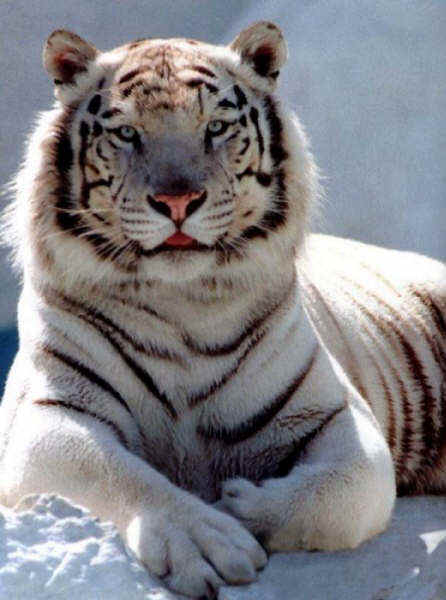
 High
Risk of Extinction in the Wild.. High
Risk of Extinction in the Wild..
Sounds of Roaring Tigers: Be careful if you have any kitties. I accidentally played
one of these sound-roars too loudly and our kitty jumped a foot in the air. She was
truly terrified by
it
http://new.wavlist.com/soundfx/007/index.html
http://www.sv.vt.edu/classes/ESM4714/Student_Proj/class95/physics/speed.html
|
The Tiger
By William Blake
1757-1827
TIGER, tiger, burning bright
In the forests of the night,
What immortal hand or eye
Could frame thy fearful
symmetry?
In what distant deeps
or skies
Burnt the fire of thine
eyes?
On what wings dare he
aspire?
What the hand dare
seize the fire?
And what shoulder and
what art
Could twist the sinews
of thy heart?
And when thy heart
began to beat,
What dread hand and
what dread feet?
What
the hammer? what the chain?
In what furnace was thy
brain?
What the anvil? What dread
grasp
Dare its deadly terrors
clasp?
When the stars threw down
their spears,
And water'd heaven with their
tears,
Did He smile His work to see?
Did He who made the lamb make
thee?
Tiger, tiger, burning bright
In the forests of the night,
What immortal hand or eye
Dare frame thy fearful
symmetry?
|

A
Chinese Tiger Farm and Park
( http://news.bbc.co.uk/2/hi/science/nature/6745497.stm
)
The Endangered Tiger:
The Real King of Beasts
Tigers are the largest, most powerful of all the cats. They are bigger than
lions. In battle, the tiger would win.
They are supremely beautiful and terrifying.
They symbolize raw Nature in all its extremes. They have always
fascinated and awed humans. An average
male Siberian Tiger weighs 500 pounds and has a body length of
8 feet long. They are 3 feet high.
Females are somewhat smaller. Siberian tigers have paler, thicker
yellow-brown fur. The smaller Indian tigers are
reddish brown
They prefer dense thickets and the long grass tamarisk shrubs along river banks. They may live in
old ruins, caves, hollowed out trees. As
they stalk and ambush their prey. they need dense cover, as well as
water, shade and game. Some can
leap 40 feet! Well-equipped
for hunting, their keen eyesight picks up
even the slightest movement. The tiger's large,
cup-shaped ears focus sounds, making its hearing very sensitive.
A tiger's long, stiff whiskers are used as
feelers to help it maneuver through twigs and branches in the dark. The
tiger's sense of smell is also excellent.
Mostly hunting at night, they attack deer, moose, rabbits, rodents, fish,
bear, elk, lynx, pigs, cattle, goats, buffaloes
and antelopes. They do not kill again until they have finished feeding
on their last kill. Tigers defend their
territories, but are not known for eating young tigers as much as lions are.
Tigers are typically solitary hunters and prey
mainly on wild pig and deer. If prey is abundant, as in Chitwan
National Park in Nepal, their territories range
from 10 to 20km≤ for females and 30 to 70km≤ for males. In
Russia, where the density of prey is much
lower, territories vary in size from 200 to 400km≤ for females and
800 to 1,000km≤ for males.
Tigers live only 15 or 18 years in the wild. Most of this time is spent alone,
coming together only to mate.
and for a few months afterwards. "Young tigers or cubs are born from 100 to 112 days
after parents have
mated. Usually tiger cubs are born between
February and May after a gestational period of three and a half
months. The cubs weigh under three pounds at
birth and are striped. The cubs' eyes open in 15 to 16 days a
litter consists of 1 to 4 cubs, occasionally up
to 6, but only 2 to 3 will survive. The mother is responsible for
defending her cubs, while the father hunts for
food. Tiger cubs are weaned at 4 to 6 months, but depend on their
mother for food and protection for another 2
years." ( http://www.edu.pe.ca/southernkings/tiger.htm
)
The characteristic stripe patterns differ from one individual to another and from one side
of the cat's body to
the other. In fact, there are no tigers
with identical markings. Males exhibit a characteristic ruff (lengthened hairs
around the neck), which is especially
marked in the Sumatran tiger.
Soon they may live only in cages. They are disappearing rapidly in the wild. One hundred years ago,
tigers once roamed Java, Bali and eastern
Turkey. Not any more. The last Javan Tiger was seen in 1981.
Some say there are only 5,000
remaining free. Others say a lot less. "The disastrous impact of poaching and
the destruction of the natural habitat of
one of the planet's most threatened animals will be made clear tomorrow
when the Indian government is told that
its remaining tiger population could be as low as 1,300". The population
is "not viable".
"The most recent census, conducted in 2001 and 2002, put the figure at 3,642. But
many experts
questioned the way in which that count was
handled and a new census was carried out by the government-run
Wildlife Institute of India using a more
scientifically robust method. While the findings will not be formally announced
until the end of the year, preliminary results
of the new count have put the population at between 1,300 and 1,500."
( October
31, 2007 - http://environment.independent.co.uk/nature/article3112841.ece
)
These live in isolated, diminishing fragments of tropical or evergreen forests
stretching from India to
south-eastern China and from the
Russian Far East to Sumatra, Indonesia. They are being poisoned, snared,
shot and captured for profit
There is a thriving but illegal wildlife trade in tigers. The threat that poaching
poses
dwarfs the risks posed them by villagers
needing to protect livestock. "Superstition has
surrounded tigers for
centuries; their body parts are used in
Asian medicines. Necklets of tiger claws are thought to protect a child
from "the evil eye"; tiger
whiskers are considered either a dreadful poison (in Malaysia), a powerful aphrodisiac
(in Indonesia), or an aid to childbirth
(in India and Pakistan); the bones, fat, liver and penis of a tiger are prized
as medicines."
The first wave of large scale tiger slaughter came with the British Raj in the form of a
‘hunting sport’; the
local Rajahs and Maharajahs also
accelerated the process by organizing shoots for the visitors; there are many
a palaces that display ‘Tiger
Rooms’ – tiger-skin rugs, tiger-skin wall hangings, stuffed tigers, tiger-skin
upholstery,
tiger all!
"Humans have also altered the natural habitats of tigers by their destruction and
encroachment on the
tigers' feeding range; humans are
destroying their habitats by cutting down trees, moving into their preferred
locations, polluting the water and air,
and hunting their prey.
"The tiger population of the Indian subcontinent has suffered a serious decline in
the last 50 years.
It is estimated that only 200 tigers
survived in Nepal, and only 4,000 in India, up from 2,000 in the 1970s.
In the 1990s, poaching has escalated in
China and Korea, in spite of the Chinese ban on tiger products in 1993.
At one point in the 1970s, tigers'
numbers had dropped to 4,000 compared to 100,000 in the early 1900s. Today,
the world tiger population still only
numbers about 5,000 to 7,000 animals. An intense effort is under way to save
the endangered tigers. Unfortunately,
tigers are still illegally hunted for their fur, bones and other parts to supply
markets in China and Taiwan. Tigers have
been hunted to near extinction by poachers, and all subspecies have
been declared endangered." ( http://www.edu.pe.ca/southernkings/tiger.htm.)
Tiger bone used in traditional
Asian medicines sells for as much as $75
to $115 per pound, which is as much as many villagers make in a year.
Chinese consider tiger genitalia is
considered to be an aphrodisiac, a substance thought to contribute to
sexual stamina.
Results of latest Tiger census in India:
11/7/2007: http://www.hindu.com/2007/11/07/stories/2007110754970400.htm
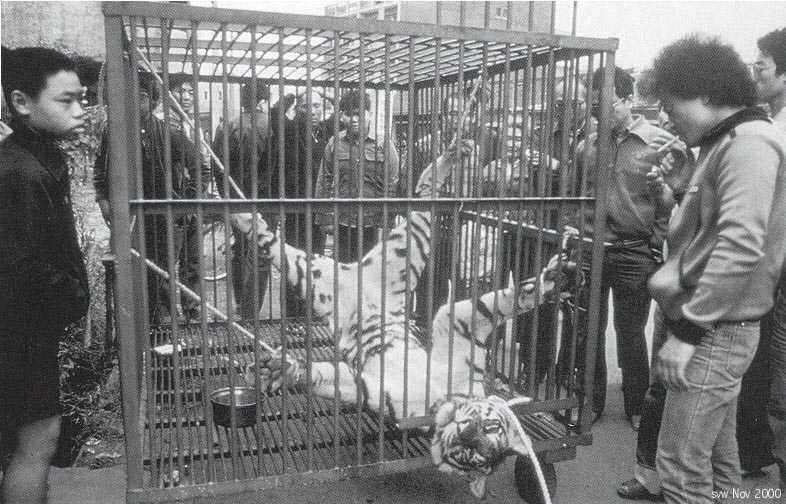
Picture of ultimate humiliation - in
Taiwan (Courtesy: website of The Realm of India's Wild & Endangered Royal
Bengal Tiger)
"Experts say the reasons for the decline of the tiger are simple. Not
enough is being done to halt
the continued poaching of the animals, which are highly
prized in China and other parts of east Asia
for their pelts and body parts. A tiger skin can fetch up
to £5,300 while tiger penises – traditionally believed
to have near-magical properties – can fetch £14,000
per kilo... Mr Thapar, 55, who has written 15 books
about tigers during three decades working with the animals,
has said it would now "take a miracle" to save
them. He warned of the impact of the Recognition of Forest
Rights Act, a piece of legislation passed last year
and expected to become law in the coming months, which
grants some of India's most impoverished
communities the right to own and live in the forests... The
problem, he said, was that all evidence showed
humans and tigers could not co-exist. "If you are not
going to set aside habitats where there are no humans
then you cannot have tigers," he said."
( http://environment.independent.co.uk/nature/article3112841.ece
)
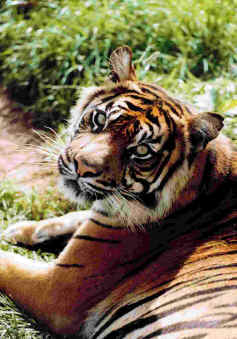
A dead
tigress was found by border guards in a snare south of Slavianka in
Khasan. It was inside the
border zone, some 2-3 km behind the fence
that runs parallel to the Chinese border. About 15 snares had
been placed along two 40 m long trails that went
up a slope. The tigress had ended up in a snare close to
the top of the slope where both trails met. She had
probably been dead for three weeks. A team of Inspection
Tiger transported the tigress to their
base. The body will be examined. (Pictures taken on Nov 19, 2004)

An area with a diameter of about 8 meters
around the tigress was trampled (see photo above). There were
no leafs left on the ground, indicating that
the tigress had tried to free herself from the snare for a long time
before she died. On a tree about 2 meters from
the tigress was a snare with a small piece of what seemed
boar fur. And twenty meters further
on there was yet another trampled area around a snare, where probably
some other animal had died.

About 500 meters from the dead tiger, in the
same valley and close to a brook, we found 7 empty plastic
bottles with Chinese writing and a name of some
chemical component in Latin script. Probably poison. In the brook
downstreams from the spot where we found the bottles were
small mazed nets placed across the brook, probably to
collect poisoned frogs.
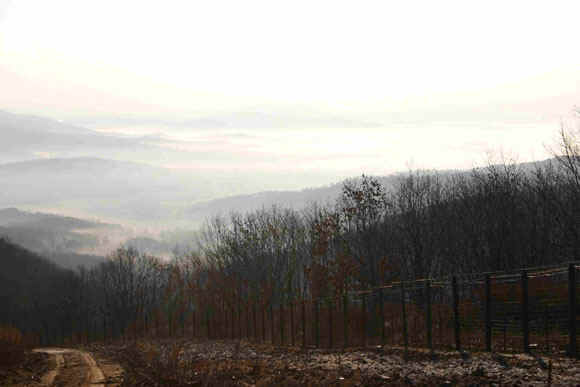
Border fence near which the tigress was found. The
fence is on the Russian side, erected at 8-12 km
from the Chinese border. ( http://www.tigrisfoundation.nl/cms/publish/content/showpage.asp?pageid=29
)
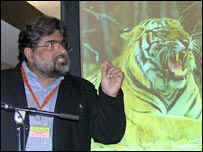 Tigers and China Tigers and China
Valmik Thapar, Conservationist
China has re-opened its domestic
trade in tiger products. The trade has been banned for 14 years,
and using material from wild tigers would
remain prohibited. Instead, traditional medicine ingredients such
as bone would be sourced from animals kept in
farms. There are thought to be at least five tiger farms in
China, housing about 5,000 animals, the
majority born and bred in captivity. Astonishingly, that is more tigers
than remain in the wild. Animal welfare
and conservation groups are virtually united in their opposition.
Valmik Thapar declares: "If there wasn't a
ban on the tiger trade, I assure you there wouldn't be one single
tiger left in India today."
China is guaranteeing an increase in poaching and signing the death warrants of
the tigers still free and living in he
wild...
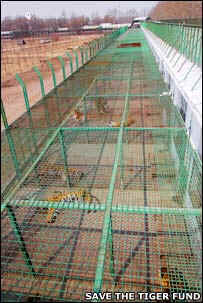
"The tiger could easily earn its keep
and buy its way out of extinction, if we allow it to do so."
Barun Mitra,
Liberty Institute, Delhi. |
Tiger Farming
In an information document, Chinese authorities lamenr the financial
difficulties which their tiger and bear farm faces.
"We need 50,000,000 RMB
($6,500,000) to run the zoo, and yet, the income from tourism was just
15,000,000 RMB ($2,000,000). "Without a fresh financial
support, the
1,000 tigers would be starving. Then, it would become meaningless to
talk about
protections of these animals." Mr Mitra's thesis
is that money should be made
from tigers in a number of ways, from ecotourism to trading in
tiger parts. The
demand for crocodile skin used, he says, to be met by poaching.
Nowadays the
supply chain starts in crocodile farms, which provide the same material
at a fraction
of the cost. As a result, crocodile numbers in the wild
have risen; and he believes
exactly the same thing could happen with tigers. |
 Russia and Tigers Russia and Tigers 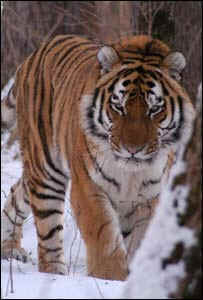
In Russian Amur (Siberian) tigers have been hunted almost to extinction. Logging threatens
the Siberian
tiger's already shrinking habitat but poaching
is the biggest threat. It has has greatly increased since the borders
between Russia, China, and North Korea opened.
"The situation is so serious that a new breed of environmentalist
has broken with peace loving green traditions,
and taken-up arms to fight tiger traffickers. Habitat destruction from
forest fires and logging are killing tigers at
a terrifying rate, but poachers are an even bigger threat. A tiger can sell
for around $1,500 (£800), but broken into body
parts, the value can soar to $50,000 (£26,500). Profits are high
and the traffickers are armed and dangerous.
In response, armed brigades Of rangers, former poachers, military
veterans of TechNet, Afghanistan and even the
Chamber Rouge, are fighting a new war on behalf of the world's wildlife.
:The battle
began in Russia in the early 1990s amid the political and economic chaos after the
collapse
of Communism. The world's biggest cats,
commonly called Siberian tigers, but correctly known as Amur tigers,
were being slaughtered at a rate of around 70 a
year and only a few hundred remained. As Amur tigers teetered
on the edge of extinction, an American called
Steve Glassier, founder of the charity wielded, arrived offering technical
expertise and money.
"With
the approval of the Ministry of Natural Resources, Steve and his colleagues established
Inspection Tiger.
Steve describes Inspection Tiger rangers as
"environmental cops" and in order to give it them the teeth they needed,
"they had to be given state inspector
status... so they could carry their own badge and guns." Although officially a
government department, Inspection Tiger is now
funded almost entirely by international wildlife charities. Since the
patrols began, tiger numbers have stabilized,
but only a few hundred remain and if left unprotected, they are at
constant risk from poachers.
"Inspection Tiger now has half a dozen anti-poaching patrols in the Russian far east,
the home of the Amur tiger.
This region shares a long border with China -
one of the world's biggest markets for tigers....In the port of Slavyanka,
just 10 miles from the Chinese border, the
anti-poaching unit is led by Andrei Yurchenko, a former lieutenant-colonel
in the Russian Special Forces.
"It is
extremely rare for a tiger poacher to be caught in the act. Even if someone is found in
possession of a
tiger skin, it is almost impossible to prove
that they actually killed the tiger. Corruption in this area is rife and not
long ago Andrei's patrol confiscated a tiger
skin from a member of the local parliament. It was obvious that the tiger
had been deliberately shot, but there was no
proof, and as a member of parliament he is immune from prosecution.
He was fined just $50 (£26) and the tiger skin
was confiscated, but the man is still in office as an elected representative."
The Amur tiger is
listed in the Russian Red Book for endangered animals, however the punishment for killing
the
state protected animal is the same as for illegal
hunting of ducks or hares. Viktor Gekht, a lawyer for the Far Eastern
Branch of WWF based in Vladivostok, said that such
punishment would never stop poachers and the federal laws
should introduce more harsh sentences on poachers
hunting for endangered species, including prison terms of five to
seven years. Andrei Yurchenko, a specialist from the
Tiger inspectorate working in the Khasan district, told the
Vladivostok News that "only if killing of a leopard or
a tiger was viewed as killing of a man could there be a chance to
improve the situation with wild cats in the Russian
Far East." In recent years the inspectors and ecologists have
cracked down on poachers but need far more rights and
stricter federal laws. The inspectors from the Tiger
organization, operating in the Far East for over 10
years, say that despite all their efforts poachers annually kill
about 30 to 40 Amur tigers. At present there are no
more than 450 of the species left in the wild."
(February 17, 2004 http://vn.vladnews.ru/Arch/2004/ISS403/News/upd17_1.HTM
)
TERNEY, RUSSIA (March 31, 2005) Olga, the first Siberian tiger
ever fitted with a radio-collar, is dead,
according to officials from the Bronx Zoo-based
Wildlife Conservation Society, who have been tracking
the big cat for the past 13 years. The 14-year-old
tiger, missing since January, is presumed killed by
poachers who destroyed her radio collar. ( http://news.mongabay.com/2005/0402-wcs.html
)
"To our knowledge, Olga is the oldest, and the
most intensively studied tiger in the world," said
Dale Miquelle, Director of the Wildlife Conservation
Society's Russia Program, and one of the people
who first radio-collared Olga. For many of us, Olga
was a symbol of the tiger's resilience and capacity
to live side by side with humans. It was a privilege
to be able to observe for such a long period, and
it's a shame that we could not have followed her
longer to witness a more dignified death from old age."

Andrei Yurchenko, a former
lieutenant-colonel in the Russian Special Forces. So his rangers are not tempted to take
bribes, Andrei subsidizes their wages from this own pocket/
"It is extremely rare for a
tiger poacher to be caught in the act. Even if someone is found in possession of a tiger
skin, it is almost impossible to prove that they actually killed the tiger." http://news.bbc.co.uk/2/hi/programmes/this_world/4305239.stm
Transcript of interview: http://news.bbc.co.uk/1/shared/spl/hi/programmes/this_world/transcripts/this_world_tiger_traffic.txt
Russian
conservation efforts receive significant support from World Wildlife Foundation
and the Phoenix Fund. To
get much
more information on Inspection Tiger, please go to
http://www.phoenix.vl.ru/zoom/ITannivers.htm
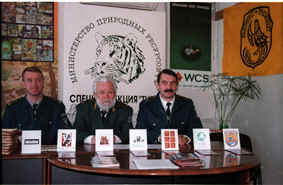
|
Poaching for Profit Understanding that local poachers are just a small link in a chain to a
multi-million dollar international network, Andrei Yurchenko decided to use the
politician's confiscated tiger skin as bait for a local illegal wildlife dealer.
A radio tracker was fixed into the tiger's head and the patrol was able
to follow the skin and see how it left Russia.
The undercover operation was filmed by several hidden cameras as part of
the BBC documentary, Tiger Traffic.
Steve Galster and his colleagues have now taken their armed conservation
approach to South-East Asia. In Thailand, the government was very slow to sanction
WildAid's operations, until a ranger and poacher were shot and killed in a national park.
Although the tragedy helped the Thai Government take the situation
seriously, patrols are still fighting apathy and indifference. Even if poachers are
successfully convicted, fines are minimal and provide no deterrence.
Last year, a car driven by a notorious wildlife dealer was stopped near
the Thailand-Laos border. Inside the car boot a tiger had been callously chopped in half
to make it fit. Despite being a repeat offender, the trafficker was fined just $150
(£80).
In Myanmar, formerly Burma, traders openly sell tiger bones, teeth,
skulls and even penises. Other traders were secretly filmed with 80 leopard skins and
although they had no tiger skins in stock, they offered to supply them for a staggering
$2,500 (£1,320), more than 30 times the price of a leopard skin.
For Steve Galster the price tag had very sinister implications.
"Tiger skins are very expensive because nobody has any at the
moment," he says.
"They're hard to find and that's because there aren't many tigers
left in the forest!" |
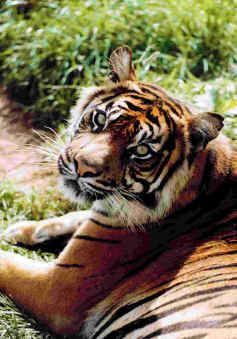 |
Panthera tigris sumatrae
The
Sumatran tiger as its name suggests is found only on the island of Sumatra in Indonesia.
It is the smallest of the tigers alive today - a Sumatran male will measure an
average of 2.4m from its nose to the tip of its tail and weigh between100-170kg.
Like all tigers the Sumatran is critically endangered because of poaching and habitat
destruction there are as few as 350 left in the wild today.
http://www.tigertrust.info/thesumatrantiger.htm
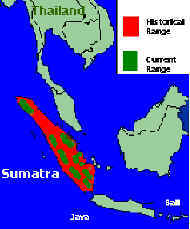 |
In 1972, India led the world in efforts to save the tiger by setting aside a number
of areas as tiger
reserves complete with patrolling guards. But
poaching continues due to widespread corruption and a lack
of alternative incomes for village populations
that continue to grow. The tiger is protected under the Convention
on International Trade in Endangered Species of
Wild Fauna and Flora (CITES), an agreement among more
than 120 nations to eliminate illegal trade in
animals and plants, such as wild tigers, and their parts and associated
products. The U.S. Fish and Wildlife Service is
the federal agency responsible for the U.S. government's compliance
with the CITES treaty.
The U.S. government imposed wildlife trade sanctions on Taiwan in 1994 for that country's
illegal trade in
tiger as well as rhinoceros parts and
products -- the first time the U.S. government has taken such action on
another country to penalize illegal trade
in critically endangered wildlife. In addition, all tiger species are listed as
endangered species under the Endangered
Species Act, prohibiting tiger parts and products from being imported
into the United States except under
certain conditions.
( http://www.fws.gov/species/species_accounts/bio_tige.html
)
Tigers have dens in caves, tree hollows and dense vegetation. They are mostly
nocturnal but in the northern
part of its range, the Siberian
subspecies may also be active during the day at winter-time. Using their sight and
hearing rather than smell, the tiger
stalks its prey and once it has reached close proximity, attacks from the side
or rear and kills by a bite to the neck
or the back of the head.
(T)igers patrol their territories
...over a period of days or weeks and it is marked with urine and feces."
( http://www.panda.org/about_wwf/what_we_do/species/about_species/species_factsheets/tigers/index.cfm
)
ZOOs Are A Poor Solution

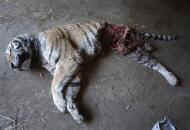 http://www.savethetigerfund.org http://www.savethetigerfund.org |
Tiger Killed in Fight Over Food at Park
Animal rights activists called Monday for improved living conditions at China's wild
animal parks after the deaths of captive tigers from disease and starvation, including a
tiger killed by four other cats in a fight over meager food supplies at a zoo in northeast
China. More... |
|
Zoo Tigers
200-300
captive animals live in zoos around the world. In addition to the 65 Sumatran tigers
living in Indonesian zoos, there are 55 tigers managed by North American zoos, 164 in
European zoos(2003), and 12 in Australasian zoos.
But, zoos may the only place the species is safe.
And more of the young survive in zoons than
in the wild.
The San Diego's Zoo' s Tiger River exhibit is
one of the best, giving the zoo's Malayan Tigers
plenty of area to exercise.
. 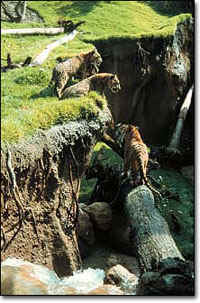
http://www.sandiegozoo.org/zoo/ex_tiger_river.html
http://www.tigertrust.info/latestnews.htm
|
STUNT TIGERS
http://www.tigerfriends.com/
http://www.mirage.com/attractions/attractions_white_tigers.aspx
Siegfried and Roy at the
Mirage - http://www.youtube.com/watch?v=PtolCP-BPkQ
part 2 - http://www.youtube.com/watch?v=lszO3tW13cQ
nice pic -
http://www.dotphoto.com/GuestViewImage.asp?AID=981620&IID=29970982&INUM=42&ICT=50&IPP=48
|
Other Tiger
Foundations That Need Help
http://www.save-tiger.blogspot.com/
http://www.dreamworld.com.au/content/standard3.asp?name=HelpingToSaveTigers
http://www.charitynavigator.org/index.cfm?bay=search.summary&orgid=7650
http://www.tigertrust.info/thesumatrantiger.htm
http://www.savethetigerfund.org/AM/Template.cfm?Section=Home1
http://www.save-tiger.blogspot.com/
http://projecttiger.nic.in/whyshouldwesavetiger.htm
http://projecttiger.nic.in/index.asp
This list will be
expanded.
Stories about Tigers
The Story of Goddess Durga
The tiger is vahana(vehicle) of goddess DURGA. Do you know that in  Nepal there is no burning of Ravana on Dusshera
because it is believed that Goddess Durga, riding a tiger, killed Mahishasura ( a
buffalo-headed demon) on the same day. Mahishasura it is said , was so powerful that none
of the gods were able to defeat him. Therefore they met together to form Durga with 18
hands, many weapons, riding a tiger. It thus shows that tiger has always been a very
important symbol of power & might. Nepal there is no burning of Ravana on Dusshera
because it is believed that Goddess Durga, riding a tiger, killed Mahishasura ( a
buffalo-headed demon) on the same day. Mahishasura it is said , was so powerful that none
of the gods were able to defeat him. Therefore they met together to form Durga with 18
hands, many weapons, riding a tiger. It thus shows that tiger has always been a very
important symbol of power & might.
The story of Lord Ayyappan:
Ayyappan was born as a
result of alliance between Siva & Vishnu when Vishnu appearded in Mohini Rupa after
churning of milky ocean. He is the third son of Siva after Ganesha and Kartikeya.
Ayyappan, was found by a childless king & queen on the bank of a river. They brought
him home as  their own child. But
when the queen had a child of her own she became jealous of Ayyappan. The queen pretended
that she was very ill & she would be cured by drinking tiger's milk. Ayyappan , who
was 12 years old volunteered & went to the forest. He returned riding a tiger followed
by all tigers of the forest. The king begged for forgiveness & asked where did Ayyapan
want his temple to be built? their own child. But
when the queen had a child of her own she became jealous of Ayyappan. The queen pretended
that she was very ill & she would be cured by drinking tiger's milk. Ayyappan , who
was 12 years old volunteered & went to the forest. He returned riding a tiger followed
by all tigers of the forest. The king begged for forgiveness & asked where did Ayyapan
want his temple to be built?
Ayyapan fired an arrow & it fell at a place Sabari. Hence, the Sabarimalai temple was
built. Both the stories thus show how important the tiger has been to our mythology. The
tiger has been an important part of Chinese, Korean, Sumerian , Japanese & European
mythologies. It is a pity that the tiger is endangered because of us humans killing it
discriminately. Killing a tiger with a sword or a spear has always been considered very
courageous.
KOREAN STORIES
The Legend of Dan-gun
In the ancient times, Hwan-In ruled the heaven. He loved his son, Hwan- Ung who was a
clever, compassionate & constructive man. One day, Hwan-Ung pleaded with his father to
let him go to earth & rule Korea. Hwan -In said yes and sent him along with Pung-Beg
(the Earl of Wind), U-Sa (the Chancellor of Rain), and Un-Sa (The Chancellor of Clouds).
The ministers were able to control rain, wind, clouds, and all natural elements. Meanwhile
a bear and a tiger lived on the earth in a cave near a sandalwood tree & wanted to
become human. Hwan-ung told them that to become humans they will have to live in a dark
cave for 100 days & eat only garlic and mugwort. The bear lived in the cave, but the
tiger was extremely restless and ran away. The bear became a beautiful woman, married
Hwan-Ung was made the Queen. Soon she gave birth to a prince, Dan-gun, or the Sandalwood
King. Dan-gun reigned as the first human king of the North Korea. Koreans believe that
the tiger still roams the mountains. Though the tiger did not become a human, even today
people's affection for the tiger is special. The tiger is seen as brave and sacred.
The Mountain Spirit
In ancient times the tiger was a messenger of the mountain spirit, San Shin.
The Matchmakng Mountain Spirit
Once upon a time there lived a rich man Kim, who had a beautiful daughter named Ok-bun.
Ok-bun became friend with a poor boy P'al-bong. Both of them were very close friends. As
they got older, Ok-bun's father realized that they loved each other & wanted to get
married. Kim decided to marry his daughter to Tol-swae, who was also a nobleman. Kim
wanted to get her married quickly & arranged for the engagement and set an early
wedding date. Both Ok-bun & P'al-bong felt very sad. On the wedding day when the
bridegroom entered the bridal chamber, where Ok-bun was waiting for him, a tiger took away
Ok-bun.
The tiger dropped Ok-bun at P'al-bong's door. In the meantime, Tol-swae searched to look
for Ok-bun. He thought she had surely been killed by the tiger. When everybody found
Ok-bun then everyone nodded and said that it was the mountain spirit, San Shin, at his
matchmaking again, and that no human should interfere. So a marriage between the two
childhood sweethearts was arranged and they lived happily every after.
References
The Tiger Call, Published in March, 1996, WWF-IndiaFolk Tales from Korea, 3rd edition, by
Zong In-Sob, 1982, Hollym International Corp: New Jersey Tiger, Burning Bright, Kathleen
J. Crane Foundation, 1992, Hollym International Corp: New Jersey (Source: http://projecttiger.nic.in/tigerstories.htm
)
Exxon and Save The Tiger Fund
ExxonMobil was instrumental in the establishment of the Save The Tiger Fund in
1995. A partnership between ExxonMobil, the National Fish and Wildlife Fund, and the
Critical Ecosystem Partnership Fund, the Save The Tiger Fund is dedicated to supporting
the conservation of Asia’s remaining wild tigers.
ExxonMobil has provided $1 million annually to support the Save The Tiger Fund since
its establishment and more than $13 million in total in tiger-range countries since
1992. This represents one of the largest corporate commitments ever made to saving a
species.
In the early '90s, many predicted that tigers would be nearing extinction in the wild by
the year 2000. Save The Tiger Fund is one of only a handful of organizations
worldwide to focus solely on tigers.
Since its establishment in 1995, Save The Tiger Fund has awarded 270 grants totaling over
$13.4 million dollars to support tiger focused projects in 13 of the 14 tiger-range
countries. Thousands of individuals, from school children to business professionals,
have joined ExxonMobil, Critical Ecosystem Partnership Fund and the National Fish and
Wildlife Foundation in contributing to the effort to save the tiger, and they are making
an impact from the snowy forests of the Russian Far East to the steamy jungles of
Indonesia.
The Fund invests in a variety of different projects that increase cooperation and
communication, build local leadership, and deliver effective on-the-ground conservation to
tigers in human-dominated landscapes.
Save the Tiger Fund grants comprise nearly one-third of all funds invested in tiger
conservation worldwide. The Fund works with international organizations such as World
Wildlife Fund, Wildlife Conservation Society and WildAid along with local native
organizations in tiger-range countries.
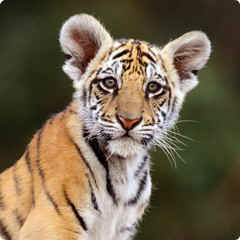 http://www.exxonmobil.com/Corporate/community_environment_savetiger.aspx http://www.exxonmobil.com/Corporate/community_environment_savetiger.aspx
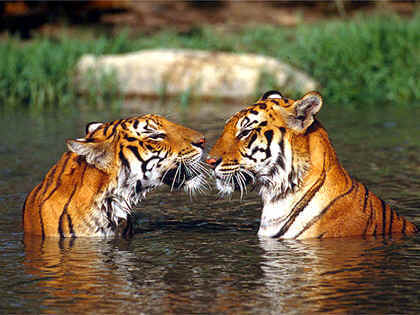
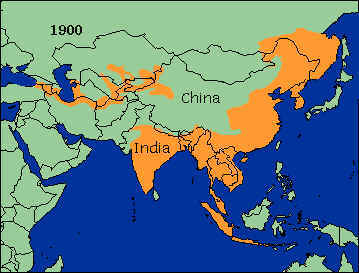
Once Upon A Time Tigers riamed widely.
See how
their range has changed over time:
http://profile.myspace.com/index.cfm?fuseaction=user.viewprofile&friendid=50238228
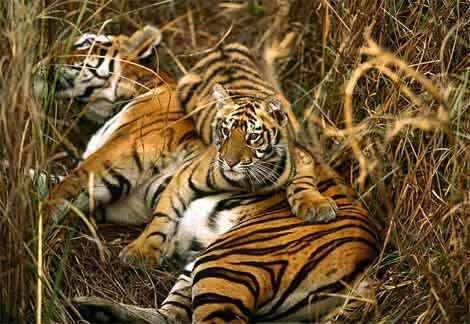
Bengal Tigers: http://animals.nationalgeographic.com/animals/mammals/bengal-tiger.html
------------------------------------------------------------------------------------------------------------------------------
White Tiger's History
Early breeding history of the white tiger in US Zoos
While lions have always been bred with ease, there
were very few records of tiger births in captivity before 1950's, according to the 1968
issue of the International Zoo Yearbook, and those that were born seldom lived to
maturity. Difficulties in breeding success were thought to be due
to the tiger's solitary nature and the aggression the female showed towards the male after
mating that discouraged further attempts to copulate. Other factors thought to interfere
with breeding success were related to vitamin and mineral deficiencies in the diet of the
times, which was commonly just horsemeat and milk. Tiger mothers often failed to care for
young, and hand rearing was not often attempted. Feline Distemper also took its toll on
cubs. These factors explain many of the early mortalities of
white tiger breeding programs. However today the tiger is a species that breeds easily in
captivity, and hand rearing is usually successful. "Research has improved diet,
kitten formulas and inoculations, but most importantly," according to Rotterdam Zoo,
a leader in early tiger breeding success, "it is the improvement in keeper knowledge
and awareness that has been the secret to the survival of tigers in captivity."
The National Zoo, Washington DC - In 1960 amidst much
excitement, the National Zoo received one of Mohan's daughters, a white cub named Mohini.
Later, when Mohini became mature, her uncle Sampson, brother of her mother Radha was
imported to be her mate. The first litter produced one white cub and two orange cubs but
only the orange male Ramana, survived. The second litter produced two more orange cubs;
one was stillborn, but the female named Kesari survived.
The National Zoo efforts concentrated on producing
white offspring. Mohini, who was born to her father and her
sister, was now mated with her orange son, Ramana. Rewati, a
white female born in 1970 was the surviving cub of this litter. At
that time the worldwide population of white tigers in captivity numbered just three dozen.
The next litter consisted of two white and three orange cubs and a day later another
stillborn was delivered. Mohini crushed three of the cubs during
her strenuous labor leaving only the white female cub Moni alive.
Cincinnati Zoo, Ohio - The National Zoo loaned the
Cincinnati Zoo the orange brother and sister pair Ramana and Kesari while it renovated its
cat habitats. This pair was grandchildren of Mohan as well as
great grandchildren of Mohan, and their father Sampson was the half-brother and uncle of
their mother Mohini. In 1974 they bred while at Cincinnati
producing a single litter that consisted of three white cubs and one orange cub. Ramana passed away a short time later. One
white male from that litter, named Ranjit was eventually sent to the Henry Doorly Zoo, the
other siblings returned to the National Zoo.
In 1976 the Cincinnati Zoo borrowed an unrelated white
tiger named Tony, on loan from John Cuneo of the Hawthorne Corporation and bred him to the
lone female white tiger Kesari. Tony was a white cub, born to
normal orange parents from a different bloodline then Mohini. Sumita
and Bhim, the white siblings from this pairing were bred to each other many times. They
produced white cubs with stripes and cubs that had almost no stripes. In April 1983 a
litter of 3 white cubs, including the first pure white tiger born were sold to magicians
Siegfried and Roy and formed the foundation stock for their white tiger program. Many other white and white-gene tigers were born at Cincinnati
and sold or traded to zoological parks in the US, West Germany, Thailand, Japan and other
counties for different valuable species.
In 1989, Cincinnati Zoo received two new female white
Bengal tigers. Sipra and Swapna were born in 1983 at Orissa Park in India and were pure
Bengal tigers. Director Ed Maruska supported the idea of breeding white tiger genes into
the Bengal population, however, the Bengal tiger was not an SSP approved animal so in the
10 years these sisters were at Cincinnati they were never bred and they passed away in the
late 1990's without contributing their genes to the US population.
Henry Doorly Zoo, Omaha, Nebraska - In 1978, Henry
Doorly Zoo received Ranjit, the son of Kesari and Ramana. Dr. Lee Simmons was in charge of
the tiger-breeding program. He was a leader who was influential in his field and located
expertise on all levels of species management to bring them together for the betterment of
conservation. This was before the creation of the first Species Survival Plan and it was
this collaboration among professionals that aided Dr. Seal to develop the concept of the
SSP adopted by AZA zoos today.
Dr. Lee Simmons was dedicated to improving the health
of the white tiger gene pool. Henry Doorly built a stock of
heterozygous tigers by pairing Rangit with normal colored tigresses, namely Mus Kative,
Soma and Tanya.
The sons and daughters of Ranjit by different mothers
were crossed to produce litters of both orange and white tigers. Offspring were mostly
healthy and free of defects, though there were individuals that had problems. Dr. Lindsey
Phillips recalls operating on a 7-day-old tiger cub to correct gastric dilation.
Heterozygous tigers Rajah and Sheba II and their
daughter Obie were purchased from Baron VonUhl of Shrine Circus to enhance the gene pool
of the Henry Doorly white tiger breeding program. Ranjit was bred to heterozygous Obie and
produced litters of white and orange cubs.
Racine Zoological Gardens, Racine, WI - In May 1984, a
white female was born to a pair of orange tigers in the Racine Zoological Garden. The
father of this cub was Chiquita, the brother to Tony, the white male owned by John Cuneo,
purchased from Baron VonUlh of the Shrine Circus. Jim Witchie, a private breeder in Ohio,
owned Chiquita. The mother of this litter was Bonnie, who was born at the Racine Zoo. Her
father Bucky came from the Indianapolis Zoo. When Bonnie was accidentally bred to her
father Bucky they produced a litter of white and orange cubs in 1982, revealing that Bucky
carried the recessive white fur gene and had passed it on to his daughter.
Columbus Zoo, Ohio - Ika, a three-legged white female
tiger on loan from the Hawthorn Corporation was paired with a heterozygous female, Dally
on lean from Cincinnati Zoo. In 1986 they produced a litter of 2 orange and one white cub.
Other white tiger bloodlines in the US Baron VonUhl -
Shrine Circus Sarasota, Florida - In addition to the progeny of the National Zoo's Mohini
and Sampson line in the US, other identifiable lines do exist. The
Baron purchased an imported Bengal tigress named Susie and a Siberian-cross tiger Kubla
from the Sioux Falls Zoo in South Dakota. These tigers apparently
carried a recessive gene for the white coats and when the Baron bred them together white
offspring unexpectedly were born. Since these cats did not have white parents, they must
have inherited the white gene from grandparents or even their great-grandparents imported
from India. Tony, the white male purchased by John Cuneo was one of their offspring. Other
litters born to this pair were sold to the Ringling Brothers Circus. Eventually,
the Henry Doorly Zoo purchased Rajah and Sheba II for their white tiger breeding program.
John Cuneo, Hawthorn Corporation, Illinois - John
Cuneo of the Hawthorne Corporation traces one of his lines back to Rajah and Sheba II, two
tigers owned by Baron VonUhl, of the Shrine Circus. Mr. Cuneo
purchased Tony, the two-year-old white offspring of this tiger pair from Mr. VonUhl.
The Hawthorn Corporation also had another line of
white gene tigers. A sibling pair of heterozygous tigers named Sheba III and Prince were
purchased from the International Animal Exchange, who had imported the pair from India. This pair produced at least five litters with two of these offspring
white. The heterozygous daughters Rani and Baby were bred to Tony to produce mostly white
litters.
The Hawthorn Corporation, which specialized in
breeding and training of tigers for circus acts, was a major leader in white tiger
breeding in the early decades, producing nearly 3 dozen white offspring by the mid
eighties.
Jim Witchie, Ohio- Private breeder/dealer Jim owned
Chiquita, the brother of Tony and used him in his white tiger breeding program selling
many offspring to other private facilities.
Josip Marcan, Florida - Josip's white tigers
originated from another bloodline from Yugoslavian imports and are of pure Bengal origin.
He has carefully maintained his Bengal purity and his breeding program produces the
snow-white tiger and golden tabby tiger as well as the classic white tiger with the
magnificent black stripes. Marcan, a doctor of veterinary
medicine, recognizes the dangers of overpopulation and limits his breeding program to
insure that his offspring have a secure future.
White Tiger Genetics
White tiger cubs are produced when the recessive gene
for the color white is inherited from both parents. There are orange tigers that have
inherited a white gene from one parent, but an orange gene from the other parent. Such
cats have one of each gene to potentially contribute to its offspring and are known as
heterozygous. It is a roll of the dice which gene is inherited. If an orange tiger that
carries the white gene is mated to a white tiger - there is a 50% chance of white
offspring, since the white tiger has only has white genes to contribute and the orange has
two possible colors to contribute. If two such heterozygous
tigers are mated, there is a 1 in 4 chance the offspring will be white. A white tiger only
has white genes for its offspring to inherit; therefore two white tigers mated together
produce only white cubs.
As this article shows, the white gene can be inherited
for many generations in an orange tiger and if it is bred with another tiger carrying this
recessive gene, seemingly spontaneous white offspring can occur. Most likely this happens
when offspring are bred to parent, such as the cases of Bonnie and Bucky, or siblings are
bred such as Sheba II and Prince, because that greatly increases the random chance that
two cats being bred are carrying the white gene. The spontaneous
occurrence of white tigers in the US shows that apparently several orange Bengal tigers
imported from India were surprise carriers of the recessive white gene.
Sadly, the AZA Zoo's Felid TAG recommended phasing out
the Bengal tigers in US collections and Species Survival Plans were developed for only
three out of five existing tiger sub-species. This change of interest meant that the work
of the previous decade performed by Henry Doorly Zoo to improve the genetics of the white
tiger bloodline was abandoned. As the AZA zoo world turned its
attentions to other sub-species, some of the white and heterozygous orange tigers were
sold and traded to private zoos such as Tanganyika, owned by Jim Fouts, and dealers such
as International Animal Exchange operated by the Hunts where they became founders of the
private sector white tiger gene pools.
44 years after Mohini arrived there are now several
hundred white tigers alive and well in the US today. That
translates into approximately 9 generations since Mohini. If all
private owners had continued to inbreed their tigers as intensively as was done in the
early history of Mohan and Mohini, this would be impossible. Inbreeding decreases
survivability by compromising immune systems and increasing genetic defects.
Inbreeding continued on the level described in this early history would
eventually result in extinction due to total loss of offspring survivability.
Instead, the opposite occurred. Through countless
out-crossings the white gene is no longer rare in the privately owned captive tiger
population. Josip Marcan guessed the white tiger population in
the US ranges from 250 to 300. Other estimates bring it closer to
400. For every white tiger there are several orange that carry
the white gene so one could be looking at 1000 tigers with this white gene. This seems to
be a reasonable estimate considering that in a privately kept white tiger studbook, 233
tigers were documented born white or heterozygous in the first 3 decades since Mohini.
It is true that some breeders operate with limited
resources and understanding of the importance of genetic diversity, inbreeding parent to
offspring or brother to sister producing cubs with hip dysplasia, cleft palates and
crossed eyes. However, many facilities produce this color variation by introducing
unrelated genetics to known white gene carriers to increase the genetic diversity and
strengthen the health of their bloodlines.
A big boost to the diversity of the white tiger
genetics happened after the US F&W S Generic Tiger Ruling in 1998 eliminated the CBW
permit requirement, allowing breeders to purchase new bloodlines in interstate commerce
without restriction - and they did. Unfortunately the boom in
breeding tigers for color produced an abundance of tigers that exceed the carrying
capacity of the available captive habitat. This overpopulation has caused instability and
is the driving force behind many of state and county ban laws passed in recent years, as
well as the Congressional passage of the Captive Wildlife Safety Act amendment to the
Lacey Act.
Two views of Conservation
Conservation is a word with many meanings. The US
Department of Interior is charged with conserving our natural resources and defines this
word to mean using habitats, resources, animals, and plants wisely so as to save them for
future generations.
The present interpretation of conservation held by AZA
zoos is that species held in captivity should be managed with possible re-introduction in
mind. This requires animals in a breeding program be the same sub-species as those found
in the wild that they might someday be released into. This dictate has caused species
managers to turn against the "generic" white tiger, even though the possibility
of actually reintroducing such a large and dangerous predator as a tiger into native
habitat is remote at best.
Just look at the facts, notes Josip Marcan, "In
1960 there were 3 billion people on this planet. In 2000 the
world population had doubled to 6 billion. In the next 40 years
experts predict 12 to 15 billion humans will be competing for space on a planet that isn't
getting any bigger. Tigers are going to be gone. They are nearly
gone now, found only in a few protected reserves. There is no sense in tiger
reintroduction unless we are going to reduce human population. China has a one child per
family policy, India does not, and India will surpass China in population shortly. The tiger's future is dependent upon captivity."
Could the white tiger survive in the wild? Outspoken
and opinionated critics like Ron Tilson of the AZA's Tiger SSP say the coloration is just
an aberrant mutation, a freak of nature destined to die out. This ignores that fact that
most animals do not see in color, and the white color of a tiger might not be any
disadvantage when hunting prey. And as this article documents
there are several wild tigers captured in India that must have carried the white gene.
One thing is for sure, we humans see our world in full
color and white attracts our attention, our admiration, and our desire - the desire to
possess, especially anything rare. Some seek to possess of the living being, others want
the trophy body. Either way, over time the white tiger was
selectively removed from nature whenever man observed it.
The white tiger lives in a captive habitat controlled
by humans. Someday, captivity may be the only environment where
any tigers live. Humans are the major selection factor that determines what genes get
passed on to the next generation. In the private sector the genes that please humanity are
the ones chosen by breeders and collectors to survive - personalities that are reliable
and stable and colors that delight the senses are selectively allowed to reproduce and
flourish.
The AZA zoo community concentrates on maintaining
three sub-species pure tiger populations, importing new pedigreed-to-the-wild breeding
stock to build up their tiny gene pools. The entire population of Indo-Chinese tigers in
the SSP had only 4 founders until more wild tigers were imported last year. The Sumatran
tiger plan has just 14 founders. Zoos continue to seek out new
wild blood in the hopes of building a captive population for future reintroduction onto
the wild. Great sums of money are spent each year for a plan that deliberately ignores the
conservation value of the already existing generic tiger population. These
tigers exist in captivity in great abundance and could be exhibited by zoos to educate the
public about the ecological role and conservation needs of the species so that wild
specimens or captive purebred subspecies are not needed.
Ironically this AZA approach to tiger sub-species
purity management might someday be universally accepted as unnecessary if the findings
published in a paper titled Tiger (Panthera tigris) molecular diversity and conservation
genetics: Progress towards a better understanding of the evolution of Asian cats submitted
by Warren E Johnson to the AZA Felid TAG receives further scientific corroboration. In this paper, Johnson writes "Relatively low genetic variation
was found among all tiger subspecies, particularly with mtDNA and DRB markers, where
tigers had tenfold less overall variation compared with other Felidae species. Genetic
homogenization of the entire species was followed by rapid dispersal throughout its
current distribution. Since 20,000 to 25,000 years ago, genetic drift and reduced gene
flow has led to a small amount of genetic differentiation among some tiger populations.
Although, recognizable, these differences are relatively slight, suggesting perhaps that
there has been insufficient time for subspecies-level genetic adaptation to be established
and that tiger populations and subspecies do not necessarily have to be managed in
isolation."
Our Spiritual Reserves
Bonnie believes that the experience of viewing the
amazing beauty of a white tiger gives us all a wake-up call on the depletion of our
diversity. She is outraged at the critics that would have the
white tiger banished from captivity. "In spite of their
early inbreeding history, private breeding programs have brought us new color variations;
the rare snow white tiger that lacks any striping, and the beautiful tabby tiger with its
dark orange stripes against an orange and white back round. These new color variations
exist today and many are perfect specimens showing no genetic defects. These amazing cats
delight audiences at educational shows and magic acts, theme parks and private zoological
facilities. Emphasis on producing the white tiger in private
facilities has mixed this white gene with much of the country's orange population,
preserving this phenotype so that future generations can enjoy them."
Bonnie reminds us that extinction is forever. "I
don't want to think of a future where our white tiger is viewed only in a picture book.
AZA has chosen to implement a policy of extinction of this gene pool in their collections.
It is up to those of us in the private sector to carefully breed our white tigers for
genetic diversity to help insure that our children, and our children's children have the
opportunity to see one of the greatest wonders of nature - the white color variation of
the Bengal tiger. This is conservation of one of the planet's most spectacular
inhabitants. Yes, it is true that this cub that lay upon my lap, and his progeny will
probably never grace the wild's of India, but his presence in our human society brings joy
and wonder and a profound appreciation for the beauty of nature and the variety of life
that will translate into an ethic that values wildness and wild places as biological and
spiritual reserves that must be protected and preserved forever."
Special thanks to the following people for providing
information for this article: A.K. Roychoudhury, G.C. Banerjee,
R. Poddar, Abhay Kunj, Gene Schmitt, Lindsey Phillips, DMV, Bonnie Ringo, Josip Marcan,
Baghavan Antel, Pat Callahan, Warren E. Johnson,
( http://www.felineconservation.org/species/Whitetigers.asp?key=38
)


 |
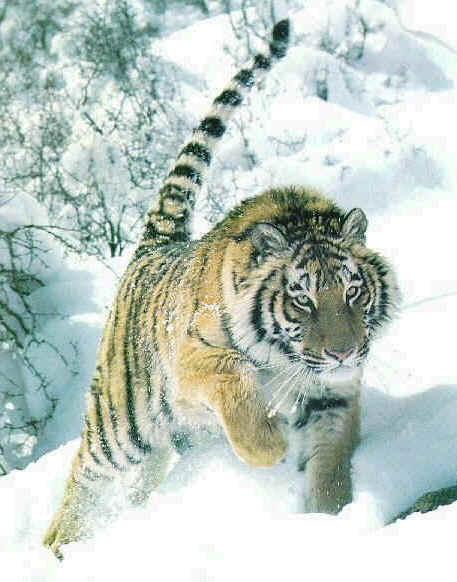

 High
Risk of Extinction in the Wild..
High
Risk of Extinction in the Wild..





 Tigers and China
Tigers and China 
 Russia and Tigers
Russia and Tigers 







 http://www.savethetigerfund.org
http://www.savethetigerfund.org
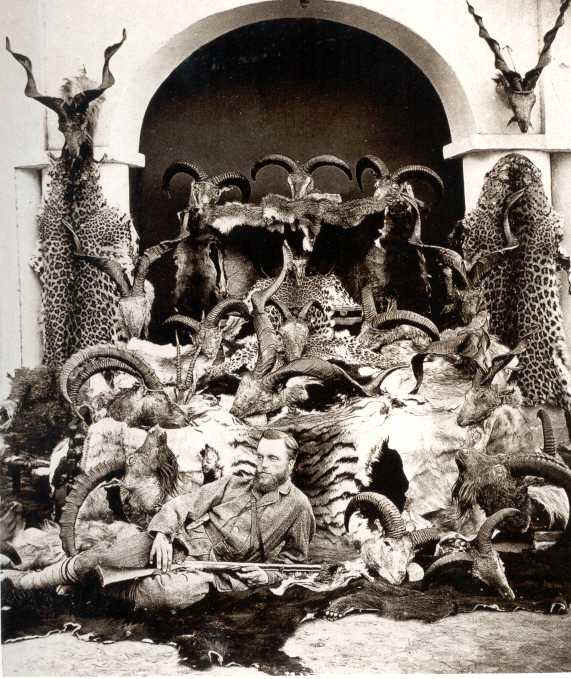
 Nepal there is no burning of Ravana on Dusshera
because it is believed that Goddess Durga, riding a tiger, killed Mahishasura ( a
buffalo-headed demon) on the same day. Mahishasura it is said , was so powerful that none
of the gods were able to defeat him. Therefore they met together to form Durga with 18
hands, many weapons, riding a tiger. It thus shows that tiger has always been a very
important symbol of power & might.
Nepal there is no burning of Ravana on Dusshera
because it is believed that Goddess Durga, riding a tiger, killed Mahishasura ( a
buffalo-headed demon) on the same day. Mahishasura it is said , was so powerful that none
of the gods were able to defeat him. Therefore they met together to form Durga with 18
hands, many weapons, riding a tiger. It thus shows that tiger has always been a very
important symbol of power & might.  their own child. But
when the queen had a child of her own she became jealous of Ayyappan. The queen pretended
that she was very ill & she would be cured by drinking tiger's milk. Ayyappan , who
was 12 years old volunteered & went to the forest. He returned riding a tiger followed
by all tigers of the forest. The king begged for forgiveness & asked where did Ayyapan
want his temple to be built?
their own child. But
when the queen had a child of her own she became jealous of Ayyappan. The queen pretended
that she was very ill & she would be cured by drinking tiger's milk. Ayyappan , who
was 12 years old volunteered & went to the forest. He returned riding a tiger followed
by all tigers of the forest. The king begged for forgiveness & asked where did Ayyapan
want his temple to be built? 


